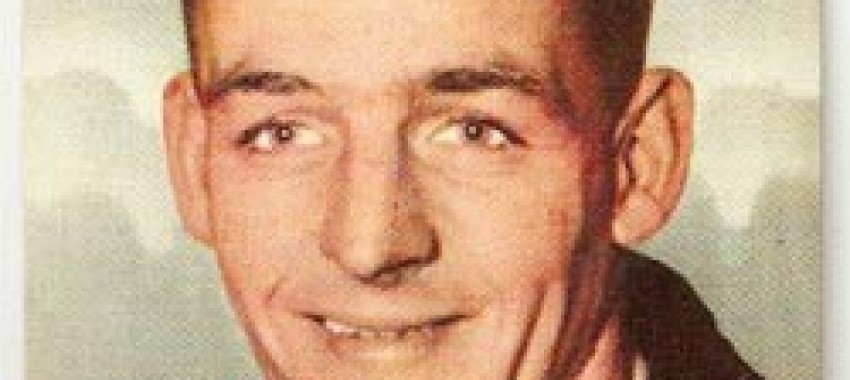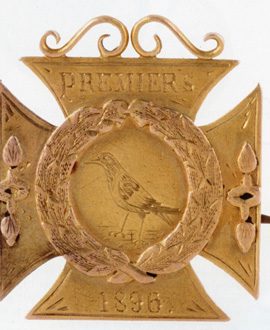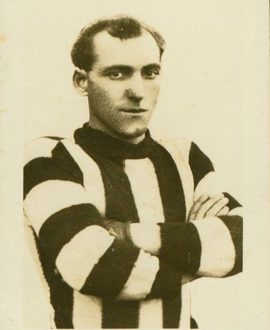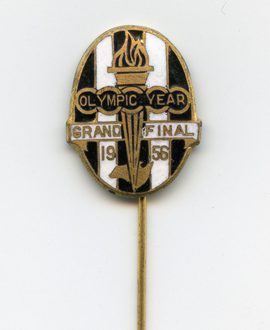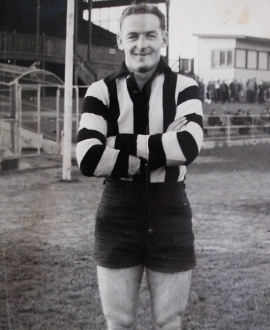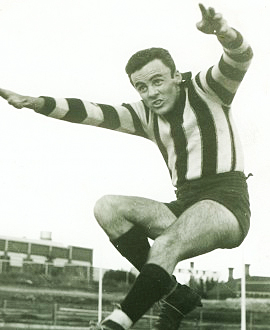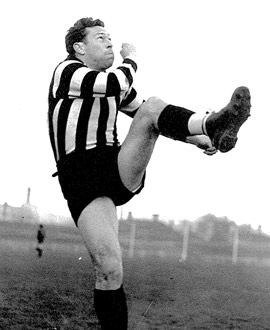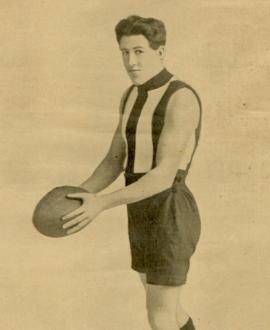Des Healey deserved much more than to be just being remembered for his last few seconds as a Collingwood footballer.
Try these achievements on for size – a Copeland Trophy winner; placed in the award on three other occasions; a Victorian representative and an All-Australian; and a man whom John Coleman once described as the best wingman he had seen.
In eight seasons across 149 games, Healey provided one third of the special centre line that included centre-man Bill Twomey and fellow wingman Thorold Merrett.
Yet for all of Healey’s achievements, he will always be instantly associated with an incident that was not of his own making, yet is still one of the first things people think about when they mention his name.
It was the crunch heard around a packed MCG, and it remains one of the most famous incidents in the history of Collingwood and Melbourne matches.
Or as Melbourne’s Ian Ridley once described it, it was “the crash to end all crashes.”
It came in the 1955 Grand Final, in the final term as the clock ticked down towards a Demons victory.
Collingwood had edged the margin back to one point at one stage of the final term before Melbourne turned on the afterburners and put some space between the two teams.
But the moment that Healey will forever be linked to came with not too long left in the match when the Collingwood star gathered a loose ball and raced down the wing, unsuspecting of anything that might be coming his way.
Twelve days after his 28th birthday, the Magpie wingman was racing at top speed as he desperately sought to take the ball forward, with time ticking down.
He was completely unaware that Melbourne’s 20-year-old reserve Frank ‘Bluey’ Adams was coming onto the ground to replace Geoff Case, and was making a speedy pathway to stop him.
A gifted foot runner, Adams was bearing down on Healey before he even knew it.
And there was an audible crack as the two footballers hit heads as the force of impact knocked both of them unconscious.
The Argus summed up the moment etched in the minds of those who were there: “Healey was breaking clear of a pack near the centre, the ball under his arms, at top speed they converged. Players and the 88,000 (it was actually 88,053) spectators waited for the elusive Healey sidestep. It did not come. The players (Adams and Healey) collided and fell unconscious.”
“Every spectator at the ground gasped as Adams flashed from the boundary line and hurled headlong into Healey with a crash that could be heard in many parts of the ground. Healey, who was racing with the ball, had no defence against Adams, who had just been sent on as a replacement for Geoff Case.”
Healey lay unconscious on the MCG turf, on his back, an arm draped almost unnaturally across his chest.
A few metres away Adams was on his side with one hand to his face, knocked out by the force of the collision and the head clash.
The game’s umpire, Harry Beitzel, had a first-hand account of the incident, saying in The Red Fox, “Out of the blue came ‘Bluey’, like a bullet out of a gun, straight at him. Poor ‘Dessy’ didn’t even see him coming.”
Years later Adams would recall in the Herald Sun: “It was quite a severe knock. He was running reasonably quickly...I was at absolute top seed.”
“It was a complete accident. Just as I was about to run on, Des has got the ball. He’s looked up and all he could see was empty space. I was going to bump him; it probably would have cost me a couple of weeks these days.
“When I got close, I dropped the head, as you do, and just kept going. He turned slightly and we just ran into each other.”
He insisted it was an accidental collision.
Adams said: “I remembered coach Norm Smith told us to go straight at Collingwood players. Smith said it was useless to pull up two yards from them as they are so clever they would baulk and dodge around you.”
Healey would jokingly tell Adams a few days later: “If you had grabbed me, I would have dropped the ball in fright. I had no idea anyone was near me and you would have got a free kick.”
Publicly, he would never blame Adams for the conclusion that would effectively end his VFL career.
“It was just football,” he said when he was resting in bed the morning after the incident.
“I didn’t see anything. I just felt a bang and it was like hitting a brick wall.”
Yet plenty of others did see an issue with what had happened. Several Collingwood players congregated around the fallen pair on the ground, eager to make a physical statement and for a brief moment it threatened to get out of hand.
The Magpies fans in the crowd roared in disapproval.
Norm Smith told the Truth years later: “If ‘Bluey’ had not been unconscious, anything could have happened. I doubt if there has ever been an uglier crowd. Hundreds decided that Bluey had deliberately charged at Des Healey to put him out of the game. It was ridiculous – would a man race at another head-on, knock himself out, to put a man out of a game already won?”
Still, more than a few Collingwood players, several officials and thousands in the crowd were wild with Adams, even though he, too, had been knocked out by the collision.
That anger would only increase when Melbourne secretary Jim Cardwell described Adams as “the idol of his club” after the incident.
“We’re very proud of him...it was an unfortunate ending to the game, but we are definitely making no apologies for the kid.”
Cardwell said Adams' action had been “suicide” but added: “He went slap bang into (Healey). And that happened because of his sheer enthusiasm and lack of experience. But his action was perfectly fair.”
Not everyone agreed.
One Demons supporter from Bentleigh wrote to the Argus: “I read with surprise and disapproval the story that ‘Bluey’ Adams was Melbourne’s idol following the unfortunate clash with him and Des Healey in the grand final. I thought Adams was reckless and I hope he has learnt a lesson. My sympathy goes to Des Healey, whose brilliant footballer won the admiration of friends and foes alike.”
Collingwood fans booed when Adams was carried off the field by three trainers, with the player completely out to it, unaware he had just made the shortest cameo of any footballer in Grand Final history. It lasted all but a matter of seconds.
Healey and Adams both lay unconscious in the rooms as players filtered back after the Demons had won by 28 points – Melbourne 8.16 (64) to Collingwood 5.6 (36).
Confusion reigned in the losing Collingwood rooms. The delay for an ambulance pushed Magpie officials to point of anger.
It was said: “They first enlisted the aid of a police patrol car to call an ambulance before the game ended, but this went to the Melbourne rooms instead. They finally got an ambulance more than an hour-and-three-quarters after play had ended.”
Healey would be taken to St Vincent’s Hospital with a badly broken nose in five places, concussion and shock; Adams went to the Alfred Hospital, suffering from concussion (he was out for 45 minutes) and shock.
Incredibly, both were released from hospital that night, and while Healey went home to bed, Adams attended the Melbourne premiership celebrations, albeit with a big headache.
By the following Tuesday night, Healey had two visitors attending his Preston home. One of them was Adams, who “called in to express his regrets for his part in the accident, and to hope that Healey would soon be fit again.”
He remembered that Healey was very appreciative of the visit, though his mother-in-law wasn’t quite as hospitable.
The second visitor was Collingwood’s secretary Gordon Carlyon, who arrived after 11pm to inform Healey that he had won the Copeland Trophy, which also carried with a 100-pound reward.
Adams remained angry at the response from the Herald’s Alf Brown to the incident. Brown heavily criticised the Melbourne player for his action.
Brown wrote: “Adams’ action was the most irresponsible one I have seen for years. He went straight at Healey as though his only object was to flatten the Collingwood champion. He succeeded spectacularly, but did not have enough football brains to protect himself.”
Adams was furious, saying later: “It was a complete accident. The company I worked for advertised in the Herald and they weren’t at all impressed, so they contacted him. He begrudgingly wrote another article the next day.”
Healey would never play another game of VFL football. In the weeks and months after the clash, he told several newspapers: “I think that might have been my last appearance in the League. I am still not certain, but I am interested in going to the country.”
By late in the year, he had been appointed coach of Wodonga. His 149-game career in Black and White would be over, as he conceded: “I couldn’t stand another blow like that.”
Adams would go on to play in another five premierships in an outstanding career with the Demons.
Healey was back playing cricket for Collingwood a few weeks later, and by chance, in October he was dismissed off Fitzroy medium pacer Carl Adams – yes, another Adams.
He would laugh: “You wouldn’t read about it...Caught and bowled twice.”
Adams found it hard to forget the incident either, particularly when Melbourne played Collingwood at Victoria Park the following year.
Healey might have been up at Wodonga at the time, but the anger was still simmering. Adams was “hooted” when he ran out on the ground and more jeers came when he started his warm-up.
The Argus wrote: “Hooting broke out every time Adams went near the ball and on several occasions orange peel was pelted at him by barrackers in front of the Collingwood grandstand.”
It got even messier after the game when one female Collingwood fan tried to take matters into her own hands.
“A teenage girl grabbed Melbourne wingman Bluey Adams, and tried to punch him as he was leaving the arena after the game at Collingwood. The brunette, aged about 16, was dressed in a tightly-fitting skirt, and a long grey sweater edged with Black and White stripes, she sprang out near a behind post at the railway end of the ground, and grabbed Adams by the Guernsey as he was about to enter the race leading to the Melbourne dressing rooms.
“Adams was completely taken by surprise and just managed to break away from the girl as she threw a right-handed punch. Apparently, Collingwood barrackers still hold a grudge against Adams...”
The postscript to the Healey-Adams incident came a few years later when the then former Collingwood player was involved in a car accident and was forced to have x-rays.
The scans would reveal that Healey had actually suffered a fractured skull in the on-field clash, not the car accident.
Healey would later return to Collingwood as an under-19s coach.
When he died in 2009, the man who would be linked with him forever would say that it was a shame that incident summed up his career.
Adams would say: “One of the things I’ve always felt sorry for Des about is he is remembered for the clash and not for his football.
“He won a Copeland, he played interstate football (and) he was a part of one of the outstanding centrelines – Healey, (Bill) Twomey and (Thorold) Merrett.”
